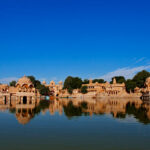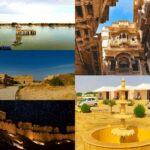Snuggled in the heart of the Thar Desert, Jaisalmer, affectionately referred to as the “Golden City,” is a mesmerizing mix of history, culture, and natural beauty. Its golden-hued sandstone architecture, which shimmers like a mirage in the desert sun, sets it apart as a one-of-a-kind destination in Rajasthan. Here’s a guide to discovering the elegance of Jaisalmer, offering an abundant tapestry of experiences that are sure to enchant every traveler.
1. Jaisalmer Fort: The Majestic Citadel
Jaisalmer Fort, also known as Sonar Quila or the “Golden Fort,” is a towering testament to medieval architecture. Constructed in 1156 AD by Rao Jaisal, this fort is one of the largest and best-preserved fortified cities in the world. Its golden sandstone walls glow magnificently against the desert backdrop, especially during sunrise and sunset. Unlike many Indian forts, Jaisalmer Fort is a vibrant, living fortress, with a significant portion of the city’s population residing within its walls. Visitors can explore winding alleys, ancient temples, and magnificent havelis (mansions), while also delving into the fort’s museums that illuminate the city’s storied past.
2. Patwon Ki Haveli: A Marvel of Craftsmanship
Patwon Ki Haveli is a collection of five opulent mansions that showcase the splendor of Jaisalmer’s merchant class. Built by Guman Chand Patwa and his sons, these havelis are renowned for their intricate carvings, frescoes, and mirror work. The largest and most elaborate haveli features elegant balconies and arches, highlighting the architectural prowess of the era. Today, this haveli complex serves as a museum, displaying antiques, artifacts, and period furnishings that provide insight into the luxurious lifestyle of Jaisalmer’s past.
3. Sam Desert: Desert Adventure
No visit to Jaisalmer is complete without experiencing the enchanting Sam Desert. Located about 40 kilometers from the city, the dunes offer breathtaking views, particularly at sunset when the golden sands take on an ethereal glow. Camel safaris are a popular way to traverse the dunes, providing a glimpse into traditional desert life. The annual Desert Festival held here is a vibrant celebration of Rajasthan’s cultural heritage, featuring folk music, dance performances, and camel races.
4. Gadisar Lake: A Serene Sanctuary
Gadisar Lake, constructed in the 14th century by Maharawal Gadsi Singh, is a peaceful oasis amid Jaisalmer’s arid landscape. Once the city’s primary water source, it is now a picturesque retreat surrounded by temples, shrines, and ghats (steps leading to the water). A tranquil boat ride on the lake offers stunning views of the surrounding scenery and the intricately carved Tilon Ki Pol entrance, making it a favorite spot for both locals and travelers.
5. Jain Temples: Spiritual Elegance
Within the confines of Jaisalmer Fort lie seven remarkable Jain temples dating back to the 12th and 15th centuries. Dedicated to various Jain Tirthankaras (spiritual leaders), these temples are celebrated for their intricate marble carvings and beautiful architecture. The Chandraprabhu Temple, dedicated to the eighth Tirthankara, is particularly renowned for its ornate dome and delicately sculpted columns. Visiting these temples provides a serene retreat and a deeper understanding of Jaisalmer’s spiritual heritage.
6. Bada Bagh: Royal Cenotaphs
Bada Bagh, or the Big Garden, is a historic site featuring a collection of cenotaphs (chhatris) dedicated to the royal family of Jaisalmer. Built in the 16th century, these intricately carved monuments offer spectacular views of the surrounding landscape. The site is especially captivating during dawn and sunset when the interplay of light enhances the beauty of the cenotaphs and the desert surroundings.
7. Thar Heritage Museum: Cultural Insights
For those interested in delving deeper into Jaisalmer’s cultural tapestry, the Thar Heritage Museum is a must-visit. The museum houses a diverse collection of artifacts, including ancient manuscripts, coins, tools, and traditional textiles. It provides a comprehensive overview of the history, culture, and customs of the Thar Desert region, offering valuable context for understanding the local heritage.
Conclusion
Jaisalmer, with its golden fortresses, opulent havelis, and enchanting desert landscapes, offers an unparalleled journey into Rajasthan’s regal past. Each sight in this golden city reveals a unique facet of its rich heritage, promising an experience that blends history, culture, and natural beauty. Whether exploring its architectural marvels or indulging in the serenity of its desert dunes, Jaisalmer guarantees a remarkable adventure that will leave a lasting impression.
For more information on exploring Jaisalmer, check out our Jaisalmer Tour Package
Discover Jaisalmer: FAQs and Answers
Q 1. What makes Jaisalmer a unique destination in Rajasthan?
A . Jaisalmer, known as the “Golden City,” stands out due to its stunning golden-hued sandstone architecture that shimmers like a mirage in the desert sun. This unique color, combined with its rich history, vibrant culture, and beautiful desert landscapes, makes Jaisalmer a one-of-a-kind destination in Rajasthan.
Q 2. What are the must-see attractions in Jaisalmer?
A . Key attractions include:
- Jaisalmer Fort: A magnificent fort built in 1156 AD, known for its golden sandstone walls and as a living fort where people still reside.
- Patwon Ki Haveli: A complex of five intricately carved mansions, showcasing the opulence of Jaisalmer’s merchant class.
- Sam Desert: Famous for its stunning dunes and camel safaris, offering a magical experience especially at sunset.
- Gadisar Lake: A serene lake surrounded by temples and ghats, perfect for a peaceful boat ride.
- Jain Temples: A group of seven temples within Jaisalmer Fort, renowned for their exquisite marble carvings.
- Bada Bagh: A historical site with cenotaphs dedicated to Jaisalmer’s royal family, providing beautiful views at dawn and dusk.
- Thar Heritage Museum: A museum with a diverse collection of artifacts offering insights into the local history and culture.
Q 3. When is the best time to visit Jaisalmer?
A . The best time to visit Jaisalmer is between October and March. During these months, the weather is cooler and more pleasant for exploring the city and its surroundings. Summers are extremely hot, and the monsoon season brings high humidity and occasional rain.
Q 4. How can I experience the local culture in Jaisalmer?
A . To immerse yourself in local culture, consider:
- Attending the Desert Festival: Held annually in February, this festival features folk music, dance performances, and camel races.
- Going on a Camel Safari: Explore the desert landscape and experience traditional desert life.
- Visiting Local Havelis and Temples: Observe the detailed craftsmanship and architectural styles that reflect Jaisalmer’s rich heritage.
Q 5. What types of accommodations are available in Jaisalmer?
A . Jaisalmer offers a range of accommodations, including luxury hotels, heritage havelis, and budget guesthouses. For a unique experience, you might consider staying in a heritage haveli or a desert camp, which provide a traditional Rajasthani atmosphere with modern amenities.
Q 6. How can I travel to Jaisalmer?
A . You can reach Jaisalmer by:
- Air: The nearest airport is Jaisalmer Airport, with flights connecting to major cities like Delhi and Jaipur.
- Train: Jaisalmer is well-connected by train, with direct services from cities such as Delhi and Jaipur.
- Road: You can drive or take a bus from major cities in Rajasthan like Jaipur, Udaipur, and Jodhpur.
Q 7. What are some local dishes to try in Jaisalmer?
A . Local Rajasthani cuisine includes:
- Dal Baati Churma: A traditional dish of lentil curry, round wheat rolls, and a sweet crushed wheat mixture.
- Gatte Ki Sabzi: A curry made with gram flour dumplings.
- Ker Sangri: A spicy vegetable dish made from desert beans and berries.
- Rajasthani Kachoris: Deep-fried pastries with spicy lentil or potato fillings



